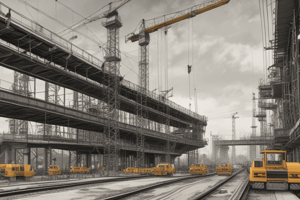Podcast
Questions and Answers
What is the primary purpose of a construction cost estimation?
What is the primary purpose of a construction cost estimation?
- To ensure the construction project is completed on time and within budget. (correct)
- To analyze the financial risks involved in the project.
- To calculate the exact cost of labor and materials.
- To determine the most efficient project design.
Which of the following is NOT a component of the capital cost for a construction project?
Which of the following is NOT a component of the capital cost for a construction project?
- Architectural and engineering design
- Construction financing
- Operating staff salaries (correct)
- Planning and feasibility studies
What is the significance of having a cost estimate before securing financing for a construction project?
What is the significance of having a cost estimate before securing financing for a construction project?
- It helps lenders assess the project's feasibility and determine the loan amount. (correct)
- It ensures that all necessary permits and licenses are obtained.
- It provides a clear timeframe for completing the project.
- It allows developers to identify potential cost overruns and adjust their budget accordingly.
How can a cost estimation impact the design and materials used in a construction project?
How can a cost estimation impact the design and materials used in a construction project?
Which factor does NOT influence the magnitude of cost components in a construction project?
Which factor does NOT influence the magnitude of cost components in a construction project?
What is the difference between capital cost and operational and maintenance costs?
What is the difference between capital cost and operational and maintenance costs?
Why is it important to include insurance and taxes during construction in the capital cost estimation?
Why is it important to include insurance and taxes during construction in the capital cost estimation?
Which of the following is NOT considered a component of construction cost?
Which of the following is NOT considered a component of construction cost?
What is the significance of accurate cost estimation in construction?
What is the significance of accurate cost estimation in construction?
What is the role of 'Overhead & Profit' in construction cost estimation?
What is the role of 'Overhead & Profit' in construction cost estimation?
Why is it essential for construction cost estimating professionals to be involved in the process?
Why is it essential for construction cost estimating professionals to be involved in the process?
What is the primary factor influencing the cost of living for a construction labor force?
What is the primary factor influencing the cost of living for a construction labor force?
Which of the following is NOT a factor contributing to labor cost in construction?
Which of the following is NOT a factor contributing to labor cost in construction?
What is the primary benefit of sourcing materials locally for a construction project?
What is the primary benefit of sourcing materials locally for a construction project?
Why is local labor force a crucial consideration for construction projects?
Why is local labor force a crucial consideration for construction projects?
What is the significance of matching the right skilled workforce to the work in a construction project?
What is the significance of matching the right skilled workforce to the work in a construction project?
What is the main factor that influences the cost of construction materials?
What is the main factor that influences the cost of construction materials?
Why is the cost of materials more complex to estimate than it initially appears?
Why is the cost of materials more complex to estimate than it initially appears?
In addition to the global market, what else should be considered when forecasting material costs?
In addition to the global market, what else should be considered when forecasting material costs?
What is the most crucial step in constructing an accurate cost estimation for a project?
What is the most crucial step in constructing an accurate cost estimation for a project?
What is the main reason why accurate quantity takeoff is vital for cost estimation?
What is the main reason why accurate quantity takeoff is vital for cost estimation?
What is the difference between the cost of labor and labor rates?
What is the difference between the cost of labor and labor rates?
Which of the following factors can affect the cost of labor in a construction project?
Which of the following factors can affect the cost of labor in a construction project?
Why is it important to consider overtime costs when estimating labor expenses?
Why is it important to consider overtime costs when estimating labor expenses?
Flashcards
Construction Cost
Construction Cost
The total expenses involved in developing properties, including all pre and post-construction costs.
Cost Estimating Professionals
Cost Estimating Professionals
Experts who evaluate and confirm the feasibility of construction cost targets before projects begin.
Factors of Construction Cost
Factors of Construction Cost
The main components influencing construction expenses: labor, materials, and overhead & profit.
Labor Costs
Labor Costs
Signup and view all the flashcards
Overhead & Profit
Overhead & Profit
Signup and view all the flashcards
Labor Force Cost Of Living
Labor Force Cost Of Living
Signup and view all the flashcards
Local Labor Demand & Supply
Local Labor Demand & Supply
Signup and view all the flashcards
Productivity
Productivity
Signup and view all the flashcards
Local Materials
Local Materials
Signup and view all the flashcards
Craftsmanship
Craftsmanship
Signup and view all the flashcards
Capital Cost
Capital Cost
Signup and view all the flashcards
Cost Estimation
Cost Estimation
Signup and view all the flashcards
Operation and Maintenance Cost
Operation and Maintenance Cost
Signup and view all the flashcards
Land Acquisition
Land Acquisition
Signup and view all the flashcards
Field Supervision
Field Supervision
Signup and view all the flashcards
Periodic Renovations
Periodic Renovations
Signup and view all the flashcards
Project Feasibility
Project Feasibility
Signup and view all the flashcards
Global Market Factors
Global Market Factors
Signup and view all the flashcards
Quantity Takeoff
Quantity Takeoff
Signup and view all the flashcards
Labor Rate Estimation
Labor Rate Estimation
Signup and view all the flashcards
Building Codes Influence
Building Codes Influence
Signup and view all the flashcards
Material Price Complexity
Material Price Complexity
Signup and view all the flashcards
FICA and FUI Costs
FICA and FUI Costs
Signup and view all the flashcards
Overtime Cost Consideration
Overtime Cost Consideration
Signup and view all the flashcards
Local and Global Market Impact
Local and Global Market Impact
Signup and view all the flashcards
Study Notes
Cost Estimating Components
- Cost estimating is a crucial aspect of construction projects.
- Construction cost is just one part of the overall project cost.
- Land acquisition, planning, feasibility studies, and entitlement processes also contribute significantly to the total cost.
- Construction is often the final major capital investment before returns.
- Cost estimation accuracy is vital for financial risk assessment.
- Cost estimating professionals verify feasibility and accuracy before construction.
Elements of Construction Cost
- Labor: Includes all man-hours, from supervision to subcontractor work.
- Overhead & Profit: Includes costs like office rent, insurance, employee wages & costs, plus a profit margin.
- Materials: This involves manufactured components, equipment, naturally occurring materials (like stone, timber), and backfilling.
Factors Affecting Construction Cost
- Labor Force Cost of Living: Directly tied to the demand and supply of labor, creating a "natural floor" for wages.
- Local Labor Demand & Supply: Construction labor is often tied to the local labor force in a given area.
- Productivity: Matching skilled labor with the work; this creates a project schedule and allows for efficient day to day operations.
- Local Materials: Using locally sourced materials is often more cost effective.
- Global Markets: The value of the dollar, the commodity market, and worldwide raw material markets are all significant cost factors.
Essential Elements in Construction Cost Estimation
- Quantity takeoff: This is the process of meticulously identifying and cataloging the required materials.
- Labor hours: Estimating the specific labor hours required to complete each stage of the project, considering labor productivity differences across stages.
- Labor rates: This includes basic wages and all related taxes (FICA, FUI), plus overtime possibilities if necessary and possible.
- Price of materials: Accurately estimating the cost of materials. This must take into account fluctuations in market demand and supply, shipping costs, and exchange rates if necessary.
- Cost of equipment: This factor must also account for rentals and/or equipment capacity.
- Subcontractor quotes: Estimating costs for subcontracted portions of the project, including labor, materials, and equipment.
Indirect Costs in Construction
- Indirect costs are equally important to consider.
- These can include: insurance; safety equipment; vehicles and equipment maintenance; cell phone, computer and software costs; payroll burden (taxes, insurance); and general office overhead.
Importance of Construction Cost Estimation
- The initial cost estimate rarely exactly matches the final cost.
- Accurate cost estimation is vital for profitability decisions, financial planning, procuring financing, and managing alterations/changes to the project.
Capital Costs for Construction Projects
- The capital cost encompasses initial facility expenses.
- Land acquisition, holding, and improvement
- Feasibility and planning studies
- Architectural and engineering design
- Construction (materials, equipment, labor)
- Supervision/inspection during construction
- Construction financing
- Insurance and taxes during construction
- Owner's general office overhead related to the project.
- Equipment and furnishings not directly related to the construction phases
- Inspection and testing of the final project
Operation and Maintenance Costs
- These occur after the initial construction phase, in subsequent years.
- Land rent (if applicable)
- Operating staff
- Labor and materials for maintenance/repairs
- Periodic renovations
- Insurance and taxes
- Financing costs
- Utilities
- Owner's other expenses
Project Resource Demands
- Construction projects require various resources.
- Different project types require different amounts of resources (manpower, materials, etc.)
Cost Estimation Approaches
- Production function: relates output volume to inputs of labor, materials, and equipment
- Empirical cost inference: relates cost to characteristics/attributes of the system using statistical techniques.
- Unit Costs for Bill of Quantities: assigns unit costs to each component/task, then sums these costs.
- Allocation of joint costs: allocates shared costs to specific tasks/characteristics of operation.
Studying That Suits You
Use AI to generate personalized quizzes and flashcards to suit your learning preferences.





